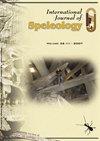Why the delay in recognizing terrestrial obligate cave species in the tropics?
IF 1.3
4区 地球科学
Q3 GEOSCIENCES, MULTIDISCIPLINARY
引用次数: 2
Abstract
“Nothing could possibly live there!” They believed. Indeed, until recently, few specialized cave- adapted animals were known from volcanic, tropical, or oceanic island caves, and plausible theories had been put forward to explain their absence. But assume nothing in science! One must illuminate, explore, and survey habitats before declaring them barren. Our understanding of cave biology changed dramatically about 50 years ago following the serendipitous discovery of cave-adapted terrestrial arthropods in Brazil and on the young oceanic islands of the Galápagos and Hawai‘i. These discoveries and subsequent studies on the evolutionary ecology of cave animals have revealed a remarkable hidden fauna and created new sub- disciplines within biospeleology. Biological surveys of caves in other regions have continued to expand our understanding of the evolution, adaptation, and ecology of the subterranean biome. We now predict that, rather than being relicts trapped in caves by changing climate, many animals actively colonized caves and adapted to exploit food resources wherever there were suitable subterranean voids. The physical environment in caves can be determined with great precision because the habitat is buffered by rock. Furthermore, the bizarre adaptations displayed by obligatory cave animals are similar across many taxonomic groups. These two characteristics make caves nearly ideal natural laboratories for studying evolution and ecology. However, to the untrained researcher, caves can appear hostile and dangerous, and in fact, fieldwork in caves requires a unique marriage of athletic ability and science. In other words, cave research is exciting! In this contribution, I describe the exploration, discovery, and research in tropical caves and describe the factors that delayed the recognition of a significant tropical cave fauna.为什么在认识热带地区的陆生专性洞穴物种方面出现了延迟?
“那里不可能有生命!”他们相信。事实上,直到最近,从火山、热带或海洋岛屿洞穴中发现的专门适应洞穴的动物还很少,人们提出了一些合理的理论来解释它们的缺失。但不要在科学上做任何假设!在宣布栖息地荒芜之前,人们必须照亮、探索和调查它们。大约50年前,我们对洞穴生物学的理解发生了巨大的变化,当时在巴西、Galápagos和夏威夷等年轻的海洋岛屿上偶然发现了适应洞穴的陆生节肢动物。这些发现和随后对洞穴动物进化生态学的研究揭示了一种引人注目的隐藏动物群,并在生物洞穴学中创造了新的分支学科。对其他地区洞穴的生物调查继续扩大了我们对地下生物群系的进化、适应和生态学的理解。我们现在预测,许多动物并没有因为气候变化而被困在洞穴里,而是积极地在洞穴里定居,并适应在任何合适的地下空隙中寻找食物资源。洞穴中的物理环境可以非常精确地确定,因为栖息地有岩石缓冲。此外,穴居动物所表现出的奇异适应性在许多分类群体中都是相似的。这两个特点使洞穴几乎成为研究进化和生态学的理想自然实验室。然而,对于未经训练的研究人员来说,洞穴可能显得充满敌意和危险,事实上,洞穴中的野外工作需要运动能力和科学的独特结合。换句话说,洞穴研究令人兴奋!在这篇文章中,我描述了对热带洞穴的探索、发现和研究,并描述了延迟对重要热带洞穴动物群的认识的因素。
本文章由计算机程序翻译,如有差异,请以英文原文为准。
求助全文
约1分钟内获得全文
求助全文
来源期刊

International Journal of Speleology
地学-地球科学综合
CiteScore
3.10
自引率
23.10%
发文量
12
审稿时长
>12 weeks
期刊介绍:
The International Journal of Speleology has the aim to get cave and karst science known to an increasing number of scientists and scholars. The journal therefore offers the opportunity to all scientists working in and on karst to publish their original research articles or their review papers in an open access, high quality peer reviewed scientific journal at no cost. The journal offers the authors online first, open access, a free PDF of their article, and a wide range of abstracting and indexing services.
 求助内容:
求助内容: 应助结果提醒方式:
应助结果提醒方式:


